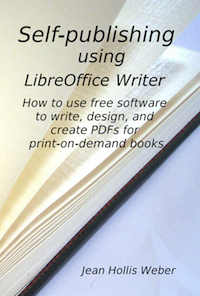David Sless of the Communication Research Institute (in Australia) is publishing a series of blog posts on the topic of rethinking communication and information design: the big shift. The series starts here and contains much food for thought.
Dec 08 2012
New book: Self-publishing using LibreOffice
EDIT 2022: This book is obsolete and no longer available.
 Self-Publishing using LibreOffice Writer:
Self-Publishing using LibreOffice Writer:
How to use free software to write, design, and create PDFs for print-on-demand books
You don’t need expensive software to write, design, and create PDFs for self-published, print-on-demand books. LibreOffice Writer is free, easy to use, and has powerful page layout features suitable for producing books such as novels and short story or poetry collections. This book explains how to write, edit, and design a book; lay out the pages using styles and templates; build a table of contents and index; include pictures, graphics, and special effects; and create a PDF for submission to POD services.
Dec 02 2012
Social media trends
Reading The Can’t-Miss Social Media Trends For 2013 reminds me how thoroughly behind I am on planning and implementing my personal use of social media for anything other than enjoyable goofing off. “Personal use” for me includes the groups for which I do volunteer work as well as things like this website.
7 Must Have Social Media Business Tools for Influence, Authority and Time Management is a related article. I am familiar with only one of the tools mentioned (Tweetdeck) although I may have heard of one or two of the others. I suspect this means I’m hopelessly behind the times.
Dec 02 2012
Talk at LibreOffice Conference 2012
Jun 21 2012
Talk at OpenHelp Conference
I presented a talk about LibreOffice documentation at this conference:

I did not produce any slides for this talk. My rough notes are here: OpenHelp Talk (PDF).
